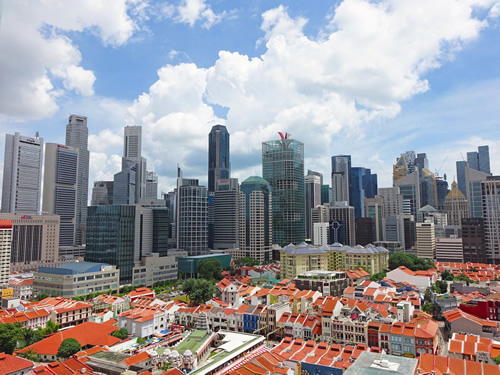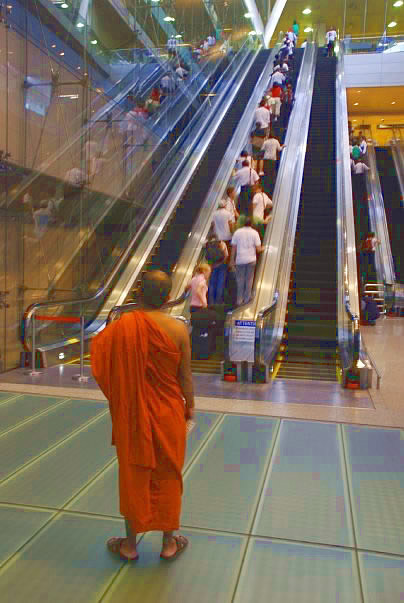Teaching English in Singapore
The Classroom Below the Skyscrapers
By Nathan Edgerton

|
|
Chinatown below Singapore skyline.
|
Bullfrogs croaked outside the door and my finger taps echoed softly against the concrete walls. My ankles were protected by the cloud of smoke from the mosquito coil under the table, but on occasion I still jerked up from my keyboard and swatted at my ears or smacked mosquitoes trapped in the hair on my arms. I was in Vietnam, marking midterm exams I had created without supervision, and deciding grades based on a scale of my own devising. (“Just give them whatever is fair,” my department head had told me when I asked about testing and grading procedures.)
A Detailed Job Offer Awaits
I took a break to check my email, and found an anxiously-awaited message from the Singapore Ministry of Education. It congratulated me on my acceptance to work as a secondary school teacher. I sighed in relief, finally knowing what I would be doing for the next year. I was excited to teach in what I had heard was an organized and effective system, consistently ranked among the best in the world in math and science.
I noticed a PDF file attached to the email and opened it. The document contained a description of the secondary school curriculum, including detailed standards about how and what students are taught, how they are tested and how they are graded, among many other details. The document was 120 pages long.
Arrival in Singapore
Four months later, I arrived in Singapore with 10 other recent college graduates as part of the first batch of untrained teachers to work in local secondary schools and junior colleges. Dave, an employee from the Ministry of Education, met us at the airport, and within minutes we were on the expressway. We cruised past a concrete colonnade of apartment buildings which vanished above the canopy of trees, planted at regular intervals, shading both sides of the highway, later emerging on an elevated highway skirting the skyscrapers of the financial district, all without a hint of congestion.

|
|
A monk considers the escalator before
entering Changi Airport. Photo by Nathan Edgerton.
|
Accommodations
We soon arrived at Bukit Timah, a neighborhood west of the city center, where we would be occupying one floor of an apartment block. We brought our things up to our flats; each had three air-conditioned bedrooms, two bathrooms with hot water and a kitchen. We had a living room with wide, breeze-capturing windows that afforded views of neighboring apartment blocks above the trees amongst them. Dave left us to rest for the remainder of the day and promised to meet us the next morning for the beginning of our week-long orientation program.
Food
Later that evening, we made our way to the nearest “hawker center,” Bukit Timah Food Court, to find dinner. Long ago, even Singapore had sidewalk soup vendors and tricycle-mounted noodle carts, much like most cities in Southeast Asia still have today. However, the government decided that these blocked the sidewalks and were fostered germs, so it outlawed street food and opened hawker centers near housing communities around the island where vendors could rent a stall to cook and sell their food.
We browsed the halls, restraining ourselves from buying either bowls of laksa (a Malay curried soup) or Japanese udon until we had seen all the choices. We made mental notes to try the phad thai and mushroom briyani later in the week, and were relieved to see pasta and pizza stalls in case we ever craved Western food. The food was cheap, so I could choose almost anything without feeling guilty. I settled on a big glass of fresh orange juice ($0.90 US) and a bowl of rice vemicelli in a salty broth with mushrooms and fresh herbs ($1.75 US).
Introductions to the Locals
As I met cab drivers, shop owners, and other Singaporeans during the next few days, I found that many were surprised to find that I was a teacher since most western ex-pats come to Singapore to work for corporations.
“Oh, you work at the Singapore American School, ah?” they would ask after a moment.
“Nope, I'm teaching at Jurong Secondary School [a neighbourhood school],” I would reply.
“Really? Why?” they would ask.
Singaporeans, unlike people of other Southeast Asian countries, are not used to encountering western teachers as part of the ex-pat population because all education is, and for decades has been, conducted in English. Yet, despite the fact that all of the teachers in the country have been educated in English, the Ministry of Education still wants to recruit foreign native English-speaking teachers. There are numerous reasons for this, such as to expose students to foreigners, to learn teaching methods, and to get feedback from people who have gone through other education systems, and, perhaps most importantly, to discourage the use of “Singlish”.
Singlish and Business
Singlish is a colloquial adaptation of English, including some Malay and Chinese words and grammatical structures, which is used casually throughout the island. Singaporeans can usually switch between proper English and Singlish, but mistakes still occur.
For example, one day in class, during a lesson involving sharks and seals, a student wanted to ask if seals had brains. She was one of the brightest students in the class, so she probably would have figured it out if she had taken a moment to think it over. However, the question came to her quickly and her hand shot up. Before I could even call on her, she blurted the answer out in Singlish. This is what she said:.
“Seal got brain one, ah?”
This, I believe, illustrates the occasional incongruence between Singlish and proper English, and one can imagine so many faint bulges of eyeballs and slight piques of brows if a Singaporean, in only a brief lapse of memory or judgment, or due to mere nervousness, said something like this in an important meeting with international clientele. Thus, foreign teachers, who more easily realize the enormity of such a mistake, can make a vital contribution toward Singapore's future business success.
Singapore: A Land of Campaigns
Though Singlish serves as a cultural bond in a country that blends significant populations of Chinese, Malays, and Indians (75%, 15%, and 10%, respectively), the government has chosen to emphasize the use of proper English, as demonstrated in its “Speak Good English” campaign. In addition, to position itself for future business with China, Singapore has launched the “Speak Mandarin” campaign. These campaigns are only two of many concurrent campaigns the government sponsors.
One day, outside a bus stop, I saw a giant banner tied between two trees and stretched across a road. In thick white letters on a black background, it warned reckless pedestrians that “Jaywalking Kills.” (I later learned that teachers had been given free sticky notepads bearing the same message, though in that case it was written in red ink, indicating blood, in the middle of tire tracks, also red with blood.) There were ads featuring 10-foot tall mosquitoes covering the sides of double-decker buses warning against the dangers of dengue fever. The tagline was “IF THEY BREED, YOU BLEED.” There were ads strung from lampposts on the sides of the highway showing a bloody hand wearing a wedding ring, lying on dark asphalt. The message was “Make it Home Safe.” There were national hand-washing campaigns and national window-washing campaigns. To see the devices used to create fear of improbable dangers is one of the most interesting parts of living in Singapore.
As one might expect from a country that counts window-cleanliness as a national concern, Singapore is a very safe place to live. The crime rate is lower than all but a few Japanese cities in worldwide rankings. Health care is reliable and affordable, and Singapore is a popular destination for medical tourism. Public transportation is extensive, convenient, and punctual. Bureaucracy is responsive, fair, and, for better and worse, by-the-book. Filling out (or, as Singaporeans say, “filling up”) and submitting forms is a kind of national labor, like harvesting rice in Vietnam and Cambodia.
Teaching
On my first day of school, 1,200 students, ordered by class in groups of 40, clad in gray shirts, shorts, and skirts, sat on the volleyball and basketball courts in front of the school. The bell rang, and they all stood up, some still chatting, some fidgeting and shifting, others rushing through the crowd to get to their assigned spaces. The second bell rang and everyone stood still and quiet. They sang the national anthem and the school song, then sat back down. After welcoming the students to the new year and making a few announcements, the principal introduced the new teachers for the year. As I took my place in line behind the new local teachers, I heard waves of giggling and mumbling rippling across the crowd. When the principal announced my name and I walked across the stage, the students burst into applause punctuated by hoots and screams. For nearly all, I was the first foreign teacher they had ever had. And for most, even in Southeast Asia's most cosmopolitan city, I was the first foreigner they had ever met.
Resources for Teaching English in Singapore
Ministry of Education Singapore: Teaching Careers
This page on the Ministry of Education's website provides information about teaching positions and application requirements, as well as application materials. It is the central source for information on teaching in Singapore Public Schools.
Princeton in Asia
This program, affiliated with Princeton University, has posts fellows that include teaching English in Singapore.
Some may be interested in teaching in private schools in Singapore, and there are also many opportunities. A few well-known schools include the Singapore American School and the German European School. There are many more schools though, so use the search for private schools in Singapore provided by the Ministry of Education if you're interested.
Recruiting agencies, such as TeachAway, also offer positions in Malaysia. TEFL training organizations sometimes offer job placement services, such as ITTT and International TEFL Academy.
Finally, Wikipedia has a good overview of the Singapore Education System.
|
Nathan Edgerton moved to Southeast Asia to teach at Can Tho University in southern Vietnam in 2007. What was supposed to be one year eventually became more than 7. In the meantime, he has taught at a public school in Singapore for a year and a half, worked as a writer in Chiang Mai, Thailand, and cycled across Vietnam.
He has been living in Bangkok for the past 15+ years, where he studied for a master's degree at Chulalongkorn University and worked for over six years as Director of Operations Development at The Knowledge, a Thai language school near the city center, and now tutors advanced students at Omega Prep.
|
